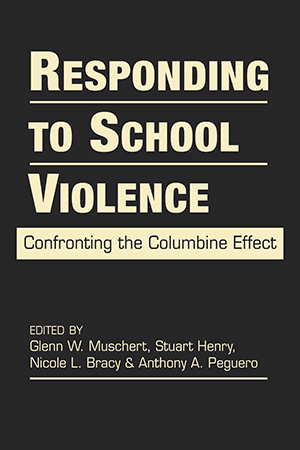Glenn W. Muschert, Stuart Henry, Nicole L. Bracy, and Anthony A. Peguero, editors
Why do so many school antiviolence programs backfire? And why do policymakers keep making the same mistakes? The authors of Responding to School Violence examine the pervasive rise of school security measures since the Columbine shootings, highlighting the unintended consequences of policymaking too often shaped by fear and sensationalism.
Probing an array of now ubiquitous tactics and programs—metal detectors, police patrols, zero tolerance policies, and more—the authors show how increasingly punitive schoolhouse dynamics negatively affect student safety and even educational experiences. They also share lessons from past mistakes and identify workable, comprehensive approaches for addressing a recurrent social problem.
Glenn W. Muschert is professor of sociology at Khalifa University.
Stuart Henry is professor of criminal justice at San Diego State University.
Nicole L. Bracy is adjunct professor of criminal justice at San Diego State University.
Anthony A. Peguero is a professor in the T. Denny Sanford School of Social and Family Dynamics and the School of Criminology and Criminal Justice at Arizona State University.
Also in the series:
Making Sense of Social Problems edited by Joel Best and Scott R. Harris,
The Paradox of Youth Violence by J. William Spencer, and
Meth Mania: A History of Methamphetamine by Nicolas L. Parsons.
"This highly accessible volume [provides] a broad introduction to school violence policy approaches and their social consequences."—Odis Johnson, Contemporary Sociology
"An excellent treatment of the contexts, policies, and alternatives to the 'Columbine Effect.' The book effectively interconnects the complex micro-to macro-level processes that can help explain and prevent a rampage attack on a school, while exposing the inherent limitations and sometimes harmful effects of current practices."—Jonathan Kremser, Criminal Law and Criminal Justice Books
"Capture[s] the complexities and repercussions of school violence.... This thought-provoking book is a significant contribution to the field."—Choice
"A much needed evaluation and critique of the narrowly focused school antiviolence policies that emerged in the wake of the Columbine High School shootings in 1999."—Brian G. Sellers, Critical Criminology
"A welcome antidote to much of the school violence literature.... The authors provide a valuable critique of current practices, as well as plausible alternatives."—Gregg Barak, Eastern Michigan University
"A must-read for anyone interested in understanding how we think about and practice school safety and discipline in the post-Columbine era. This work delves deeply into how the 'Columbine Effect' is shaping the lives of our kids, and offers smart and evidence-based ways forward."—J. William Spencer, Purdue University








